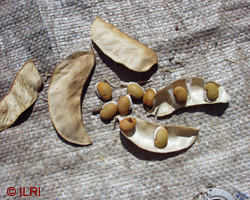Conservation of forage legume genetic resources
Contributors to this page: ILRI, Ethiopia (Jean Hanson); ICARDA, Syria (Ahmed Amri, Kenneth Street, Ali Shehadeh, Natalya Rukhkyan); GRCTPL, Australia (Richard Snowball); Bioversity International/ILRI, Addis Ababa, Ethiopia (Alexandra Jorge).
Importance of forage legume conservation
|
Grasspea seeds (photo: ILRI) |
Secure conservation is at the heart of the Centers’ stewardship of their collections and depends on the application of technical practices of high standard based on an accurate assessment and appropriate management of risks.
The adequacy of the conservation technologies in use is a key to meeting the objectives of long-term conservation of genetic diversity. Forage diversity is important because:
- As more land is coming under intensive cultivation and cropping is moving to marginal lands, much of the natural diversity of forage species will be lost.
- Demand for use of forage genetic resources for feed development for increasing livestock production as part of sustainable agricultural systems is expected to increase.
- The further study of the conserved germplasm will allow the identification of genotypes with potential for livestock feed for specific environments, re-vegetation of degraded areas and use in areas undergoing climate change.
Recognizing that the outcome of secure and long-term conservation of biodiversity may be achieved through use of different practices, a set of best practices is needed that can be applied under different conditions and with different equipment in the genebanks in both advanced institutes and the developing world.
Major forage legume collections
Currently the major forage collections in the CGIAR are maintained by the Centro Internacional de Agricultura Tropical (CIAT), the International Center for Research in the Dry Areas (ICARDA) and the International Livestock Research Institute (ILRI).
CIAT focuses on tropical grasses and legumes with emphasis on species adapted to acid infertile soils. ICARDA focuses on sub-tropical/ Mediterranean forage legumes for dry areas. ILRI has a very broad collection covering both tropical lowland and highland and sub-tropical/Mediterranean forage legumes and grasses.
Other important forage legume collections can be found in Brazil (EMBRAPA), Australia (CSIRO, CLIMA) and USA (USDA).
Comments
- No comments found





.jpg)


Leave your comments
Post comment as a guest